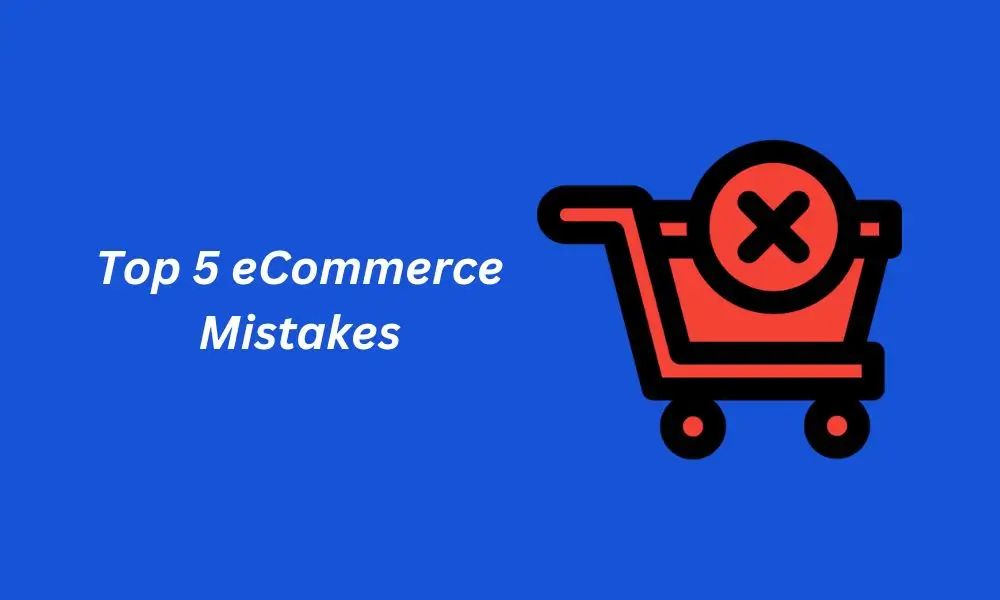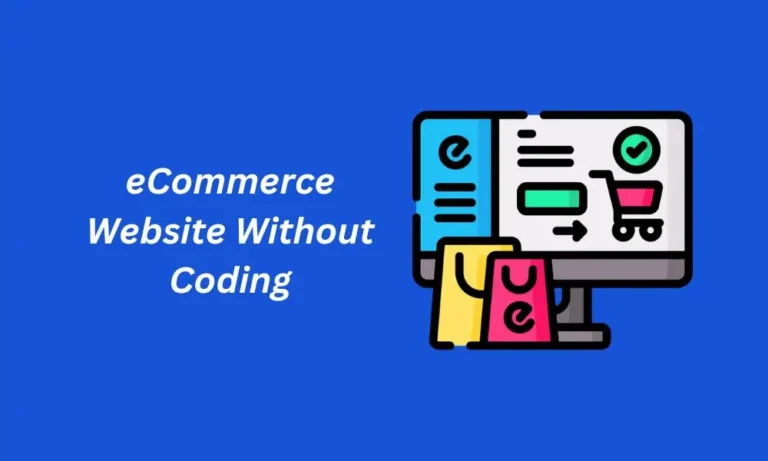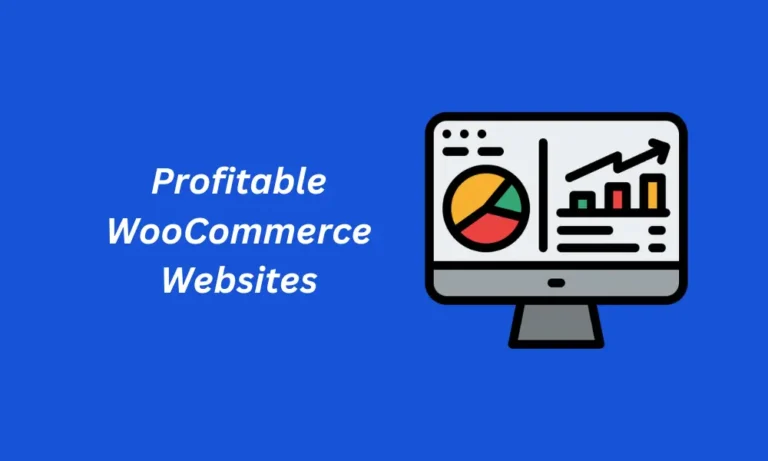In this blog post, I’ll be sharing with you top 5 eCommerce mistakes beginners make when starting out. I’ll also show you how you can avoid those mistakes.
Introduction
Starting an eCommerce business is an exciting endeavor, full of possibilities for financial freedom and personal growth. But as with any venture, the path to success can be filled with challenges.
Beginners often find themselves making critical errors that, while common, can hinder their business’s growth. If you’re new to eCommerce, this guide is for you! Let’s explore the top 5 eCommerce mistakes beginners make and, more importantly, how to avoid them.
Table of Contents
eCommerce Mistakes Beginners Make
Now it’s time delve into the eCommerce mistakes beginners make when starting their online stores. You’ll learn how to avoid these various mistakes to run a successful online store.
1. Choosing the Wrong Niche or Product
Why This is a Mistake:
One of the most common eCommerce mistakes beginners make is diving into a saturated market or selecting a product they’re passionate about without researching its demand. While passion is vital, it won’t pay the bills if no one else shares your enthusiasm. Selecting the wrong niche can lead to slow sales, stiff competition, and an uphill battle in generating traffic to your store.
How to Avoid This Mistake:
- Conduct Market Research: Use tools like Google Trends, Ahrefs, or SEMrush to gauge the demand for a product or niche. Identify emerging trends, and aim to enter markets where there’s steady demand but less competition.
- Validate Your Product Idea: Before investing significant time or money, validate your product by setting up a simple landing page or conducting a survey to see if potential customers are interested in what you’re offering.
- Balance Passion with Profit: It’s great if you’re passionate about your product, but ensure it’s a viable business idea. Find the sweet spot between personal interest and market profitability.
2. Underestimating the Importance of a User-Friendly Website
Why This is a Mistake:
Beginners often make the mistake of prioritizing flashy designs or overly complex websites that confuse and frustrate potential customers. Your website is your digital storefront, and if it’s hard to navigate, loads slowly, or isn’t mobile-responsive, visitors will leave, and your bounce rate will skyrocket.
How to Avoid This Mistake:
- Prioritize User Experience (UX): Simplicity is key. Ensure your site is easy to navigate, loads quickly, and provides a seamless user experience across all devices (desktop, mobile, and tablet). Platforms like Shopify and WooCommerce offer user-friendly themes and designs that are optimized for eCommerce.
- Use Clear CTAs (Call to Actions): Guide your visitors through your sales funnel with clear, compelling calls to action. Buttons like “Buy Now,” “Add to Cart,” and “Learn More” should be prominently displayed.
- Optimize for Mobile: Since a significant portion of online shoppers use mobile devices, it’s essential that your site is mobile-friendly. Use mobile-optimized themes and test your site’s performance across multiple devices.
3. Ignoring the Power of Marketing and SEO
Why This is a Mistake:
A beautiful, functional website is useless without traffic. One of the most critical eCommerce mistakes beginners make is thinking that “if you build it, they will come.” In reality, no one will come unless you actively market your store. Additionally, failing to incorporate search engine optimization (SEO) into your strategy means you’re missing out on organic traffic opportunities.
How to Avoid This Mistake:
- Invest in SEO Early On: From the moment your website goes live, prioritize SEO. Use keyword tools to find relevant phrases (such as “ecommerce mistakes beginners make”) and incorporate them into your product descriptions, blog posts, and metadata. Optimize for both on-page SEO (content, tags, keywords) and off-page SEO (backlinks, social signals).
- Leverage Social Media: Create accounts on major platforms like Instagram, Facebook, TikTok, and Pinterest to promote your store. Share user-generated content, run contests, and engage with your audience to build brand loyalty.
- Paid Advertising: Once you have some capital, consider investing in paid ads (Google Ads, Facebook Ads, Instagram Ads). While it can be overwhelming, tools like Facebook Pixel allow you to target your ideal customers more effectively, increasing your chances of converting traffic into sales.
4. Not Focusing on Customer Service and Retention
Why This is a Mistake:
It’s far more cost-effective to retain an existing customer than to acquire a new one. Yet, many beginners focus solely on attracting new customers and neglect customer service, leading to poor reviews, returns, and one-time buyers. Ignoring customer service can harm your reputation, and recovering from that can be challenging.
How to Avoid This Mistake:
- Prioritize Customer Support: Respond promptly to customer queries and resolve issues as soon as they arise. Implement live chat tools and ensure your contact information is easy to find on your website.
- Create a Loyalty Program: Offering discounts, rewards, or exclusive deals for repeat customers can significantly increase customer retention. Programs like these foster long-term relationships and encourage buyers to return to your store.
- Send Follow-Up Emails: After every purchase, send a thank-you email along with a request for feedback or reviews. A well-executed post-purchase email sequence can encourage future sales and create brand advocates.
5. Mishandling Inventory and Fulfillment
Why This is a Mistake:
Inventory management is one of the most complicated aspects of running an eCommerce business. Beginners often misjudge product demand, leading to stockouts or excess inventory. Either scenario can harm your business—stockouts cause missed sales, while too much stock ties up cash flow and storage space.
Additionally, fulfillment delays or mistakes can tarnish your brand’s reputation and lead to customer dissatisfaction. Shipping issues, lost orders, or incorrect product deliveries are all too common when fulfillment processes aren’t managed properly.
How to Avoid This Mistake:
- Start with Dropshipping: If you’re new to eCommerce and unsure about managing inventory, dropshipping can be an excellent way to start. In this model, you won’t handle the inventory, as the supplier will ship directly to the customer. This reduces your upfront costs and minimizes the risk of having unsold stock.
- Use Inventory Management Software: Once you start stocking products, use software to track inventory levels, predict demand, and alert you when it’s time to reorder. Apps like TradeGecko or Stocky integrate seamlessly with platforms like Shopify.
- Outsource Fulfillment (If Necessary): As your business grows, it may make sense to outsource fulfillment to third-party logistics providers (3PLs) like Fulfillment by Amazon (FBA) or ShipBob. These services will handle storage, packing, and shipping, allowing you to focus on scaling your business.
Conclusion
While it’s easy to get caught up in the excitement of launching an eCommerce store, understanding the common pitfalls can save you time, money, and frustration. By avoiding the top 5 eCommerce mistakes beginners make — choosing the wrong niche, neglecting website functionality, overlooking marketing and SEO, ignoring customer service, and mishandling inventory—you’ll set yourself up for success.
Starting an eCommerce business isn’t without challenges, but with the right knowledge, tools, and perseverance, you can create a thriving online store. Focus on steady growth, learn from mistakes, and most importantly, stay adaptable in this ever-evolving digital marketplace.
By avoiding these errors and implementing the best practices outlined in this guide, you’ll be well on your way to building a successful eCommerce business that not only survives but thrives in today’s competitive landscape.
Frequently Asked Questions
1: How much money do I need to start an eCommerce business?
It depends on the business model. If you’re dropshipping, you can start with as little as a few hundred dollars for your website and marketing efforts. However, if you’re managing inventory, you’ll need more for product sourcing, warehousing, and fulfillment. Budgeting for at least $1,000 to $3,000 for a small inventory-based business is typical.
2: Do I need technical skills to build an eCommerce store?
No, with platforms like Shopify, WooCommerce, and BigCommerce, you don’t need coding knowledge to start. These platforms offer easy-to-use, drag-and-drop builders that allow beginners to create professional eCommerce stores without technical expertise.
3: How do I handle returns and refunds in an eCommerce business?
Returns and refunds are inevitable in eCommerce, so you need to have a clear policy in place. Make sure your policy is easy to understand, and don’t make it overly complicated for customers to return products. Respond to return requests promptly and aim to make the process as smooth as possible. Providing prepaid return labels can increase customer trust.
4: How can I stand out from the competition?
- Branding: Invest in developing a strong brand identity that sets you apart from competitors. This includes your logo, website design, product packaging, and voice.
- Unique Selling Proposition (USP): Define what makes your product or service unique. Whether it’s quality, price, customer service, or innovation, ensure you can clearly articulate why customers should choose you over others.
- Customer Experience: Offering exceptional customer service, fast shipping, and personalized touches can leave a lasting impression and foster loyalty.
Q5: How long does it take to see profits in an eCommerce business?
Profitability depends on several factors, including your niche, product margins, marketing efforts, and how well you manage your expenses. Some businesses can break even within a few months, while others may take a year or more to see consistent profits. Be patient, track your performance, and adjust your strategies as needed.




